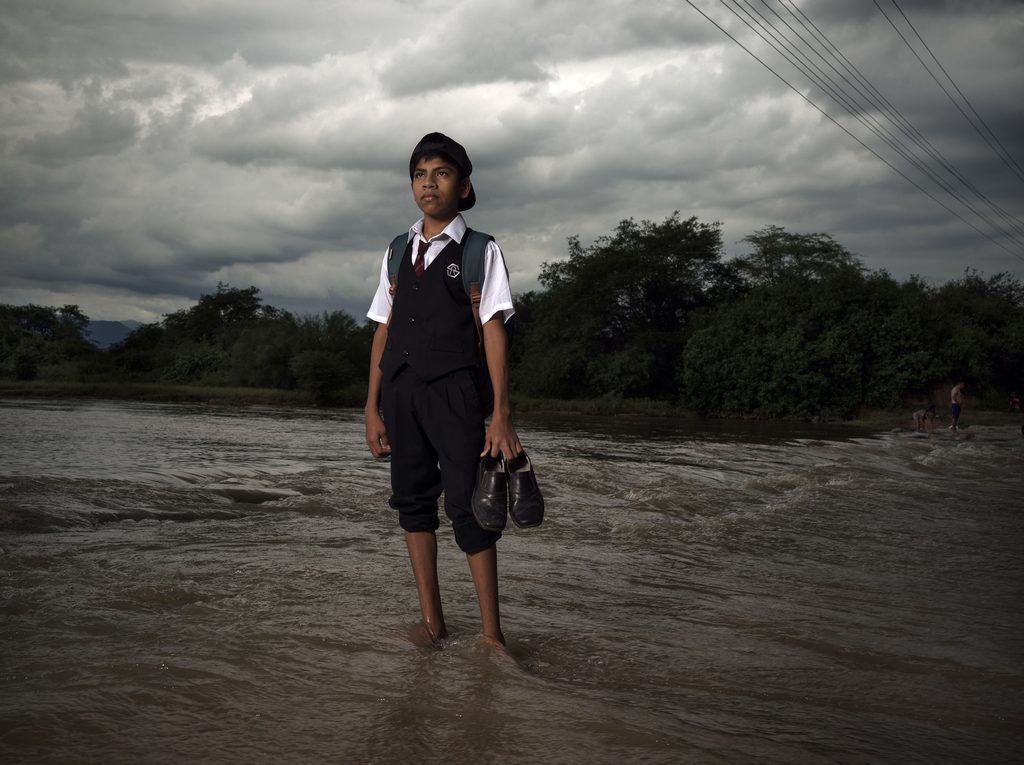Life in Stalin’s village in Piura, Peru is shaped by more than just sandy roads and soccer games. Every rainy season, the river near his home overflows and turns daily life upside down.

A big village, a small obstacle called the river
Stalin is 14. He lives with his mom, dad, and younger brother in a large, sandy village near a river in Piura – Peru. His two older sisters have already moved out. Like most teenagers, Stalin enjoys playing football and using his phone. He’s currently in the third year of high school and enjoys hanging out with friends at school, especially during breaks in the back soccer field.
But life in Stalin’s village is shaped by more than just sandy roads and soccer games. Every rainy season, the river near his home overflows and turns daily life upside down.
“The worst thing about living in my community is the river. It overflows when it rains. The force of the water is strong, and sometimes people die as they are pulled away by the water.”
When the river is high, Stalin can’t visit his grandparents. Roads are cut off. Motorbikes avoid the area. Even getting food becomes a challenge.
“Only military trucks can cross. My family doesn’t want me to take risks, so we stay at home.”
“The worst thing about living in my community is the river. It overflows when it rains. The force of the water is strong, and sometimes people die as they are pulled away by the water.”
Stalin (14)
Education interrupted
For Stalin, the river doesn’t just mean danger—it also means missing school.
“In the rainy season, I mostly don’t go to school because of the river. It’s difficult to understand the homework when I miss class.”
He tries his best to stay connected: contacting classmates, doing homework at home, and catching up when he returns. But it’s not always easy.
“Sometimes I feel estranged. Ideally, all my classmates would be at the same level. But I cannot keep up with them. I feel I am skipping class too much.”
Teachers know where Stalin lives and understand his situation. Many of them also can’t reach the school during heavy rains, so entire classes get canceled.
“In the rainy season, I mostly don’t go to school because of the river. It’s difficult to understand the homework when I miss class.”
Stalin (14)
Cost, distance, and effort
Beyond the floods, there’s another barrier: cost.
“During the rainy season, the prices increase. If we don’t have a motorcycle, we have to pay 12 soles to come to school. It’s expensive.”
Walking could be an option, but his mother worries about the risks. When Stalin finally makes it to school after missing classes, he often asks for extra time and help, especially in subjects like math.
“Sometimes I get lower grades because I missed topics that were discussed in class.”
And that’s hard on him. “When I can’t come to school, I feel sad because I know I will fall behind.”
“During the rainy season, the prices increase. If we don’t have a motorcycle, we have to pay 12 soles to come to school. It’s expensive.”
Stalin (14)
Dreams beyond the river
A few years ago, heavy rain broke through the school roofs, and classes had to move to WhatsApp. It didn’t work well. Yet despite the challenges, Stalin dreams big.
“When I grow up, I want to be a civil engineer. I would improve the houses in my village and build a bridge so it is easier for children to come to school, even when it rains.”
A step forward, even when it rains
Today, Stalin is part of the Safe Horizons: Andean Alliance for Disaster-Resilient Education project—funded by ECHO and implemented by Plan International in Peru, Ecuador, Colombia, and Bolivia. The initiative supports thousands of children and adolescents in gaining continued, safe, and inclusive access to education, even in the face of floods, landslides, and other threats that affect their daily lives.
It’s not about changing their reality, but about reinforcing the paths they are already walking.
Like Stalin, more than 45,300 people are being engaged in conversations around the importance of education access, school continuity, and protection of learning journeys. Over 8,400 students will receive tools and knowledge to prepare for disasters and strengthen safety in their schools.
This is one more step that helps Stalin—and thousands like him—keep learning, no matter the weather.
